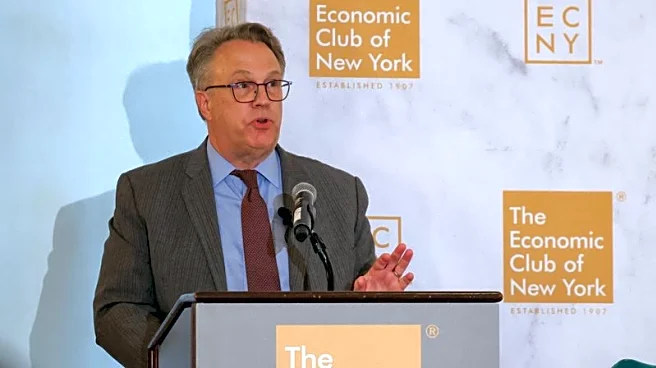What's Happening?
The Federal Reserve is experiencing significant internal division regarding its upcoming interest rate decision, which could lead to an unprecedented tie vote. The Federal Open Market Committee (FOMC)
is set to meet on December 9-10, 2025, to discuss potential rate cuts. Recent comments from policymakers have leaned hawkish due to inflation remaining above the Fed's target, reducing expectations for further easing. However, New York Fed President John Williams has indicated there might be room for rate adjustments, increasing the likelihood of a rate cut. Analysts from Capital Economics have noted that the committee could face a six-six tie, as Fed Chair Jerome Powell and Governor Lisa Cook often align with Williams. This situation is complicated by the fact that the FOMC's rules do not explicitly address tie votes, leaving the outcome uncertain.
Why It's Important?
The potential for a tie vote at the Federal Reserve is significant as it could impact monetary policy and economic stability. Interest rate decisions influence borrowing costs, consumer spending, and business investment, which are crucial for economic growth. A deadlock could maintain current rates, affecting sectors reliant on lower borrowing costs, such as housing and consumer goods. The uncertainty surrounding the Fed's decision may also affect financial markets, as investors seek clarity on future monetary policy. Additionally, the division within the Fed highlights challenges in achieving consensus amid differing economic outlooks, which could influence future policy-making processes.
What's Next?
If a tie vote occurs, the federal funds rate would remain unchanged, as there is no override provision for the Fed Chair to force a decision. This could lead to a revote either during the same meeting or at the next scheduled meeting. The situation may prompt the FOMC to consider revising its rules to address tie votes explicitly. Investors and stakeholders will closely monitor the Fed's actions and statements for indications of future policy directions. The outcome of the meeting could also influence market expectations and economic forecasts, as stakeholders assess the Fed's ability to navigate internal divisions.












